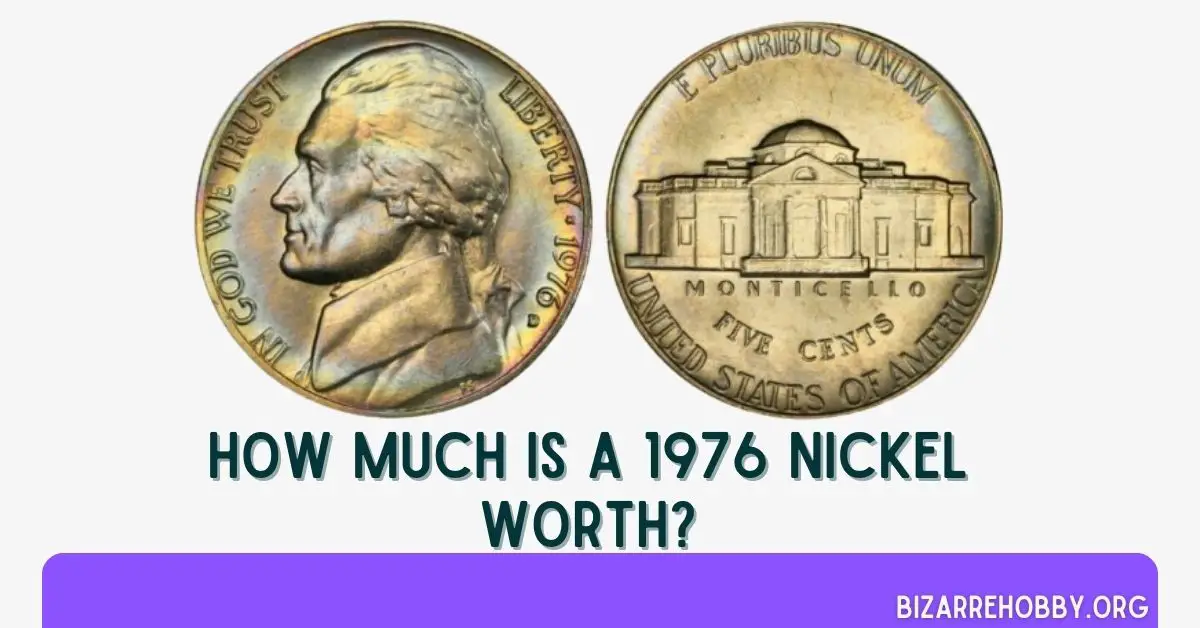The 1976 nickels are five-cent coins minted in three different locations: Philadelphia, Denver, and San Francisco. The Philadelphia mint produced nickels without any mint mark, while the Denver mint issued coins with a “D” mint mark. Proof coins, known for their high-quality finish, were exclusively minted in San Francisco. The value of a 1976 nickel can vary significantly based on its mint origin, condition, and overall appearance.
Value Charts for 1976 Nickel
| Condition | 1976 Nickel | 1976 D Nickel | 1976 S Nickel |
|---|---|---|---|
| MS 60 | $1 | $1 | – |
| MS 65 | $18 | $14 | – |
| PR 65 | – | – | – |
Historical Significance of the 1976 Nickel
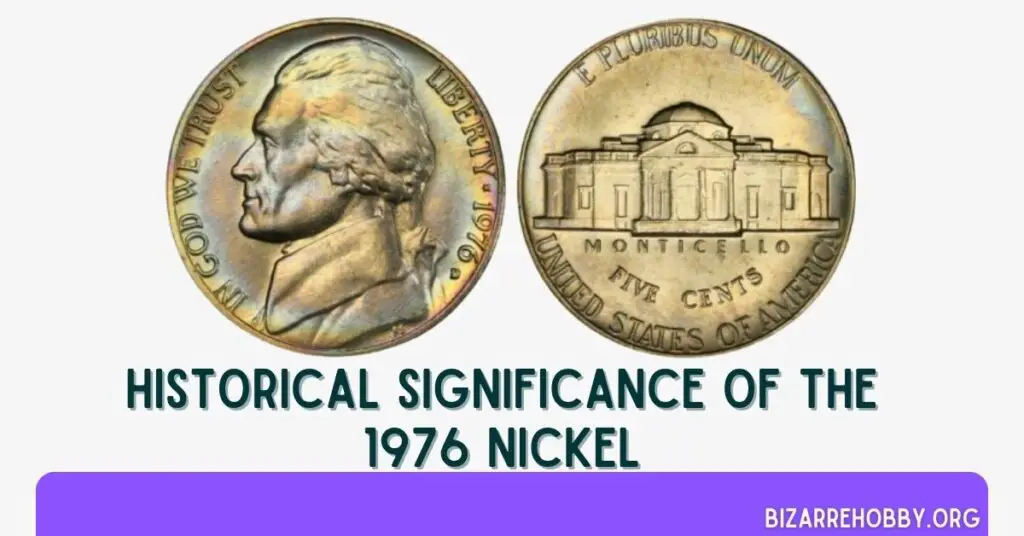
The Jefferson nickel was introduced as a replacement for the Buffalo nickel, which had been in circulation since 1913. Despite their popularity, Buffalo nickels were discontinued due to design issues during minting.
The new nickel design honored Thomas Jefferson, born in 1743, who was a principal author of the American Declaration of Independence and the third President of the United States. However, it’s important to note that Jefferson, a lawyer and architect, enslaved over 600 people of African descent at his Monticello plantation.
In the 1930s, the US Mint sought a new design for the five-cent coin and organized a competition in 1937, inviting numerous American sculptors and artists. Out of 390 submissions, Felix Schlag’s design was selected.
Schlag, a German-born artist, created an elegant and simple design featuring Jefferson’s profile on the obverse and Monticello on the reverse. Initially, Schlag’s initials were not included in the design, but they were added in 1966.
The first Jefferson nickels were issued in 1938 from three mints. Production began in October 1938 after modifications to the initial reverse design. Until 1964, the mint mark was located on the reverse, to the right of Monticello.
The composition of the Jefferson nickel changed only once during World War II, when the coin included silver and manganese in addition to copper. These “war nickels” featured a large mint mark above Monticello and were minted starting in October 1942. The original composition and mint mark position were restored in 1946. Jefferson nickels continued to be produced until 2004, when the design was updated.
Today, Jefferson nickels are popular among collectors due to their historical significance. The 1976 Jefferson nickels share the same composition as the original 1938 coins and maintain a similar design, with the primary difference being the location of the mint mark.
1976 Nickel Types
| Location | Year | Minted |
|---|---|---|
| Philadelphia | 1976 Nickel | 367,124,000 |
| San Francisco | 1976 S Proof Nickel | 4,149,730 |
| Denver | 1976 D Nickel | 563,964,147 |
| Total | – | 935,237,877 |
Design of the 1976 Nickel
The 1976 US five-cent coins, known as Jefferson nickels, were first introduced in 1938. Felix Schlag’s iconic design has remained largely unchanged over the decades.
Obverse Design of 1976 Nickel
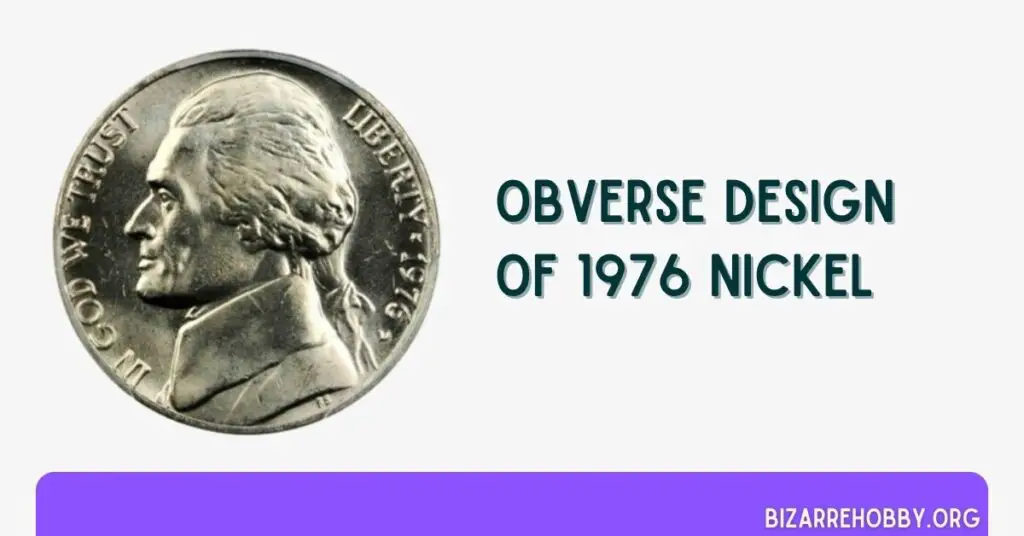
The obverse side of the 1976 Jefferson nickel features a bust of Thomas Jefferson, adorned with an 18th-century wig. Below the collar’s right corner, you’ll find the designer’s initials, FS.
This side of the coin also includes two prominent inscriptions framing Jefferson’s profile: “IN GOD WE TRUST” on the left and “LIBERTY” on the right, separated from the minting year by a star.
The motto “IN GOD WE TRUST,” first used during the Civil War, became official in 1956 to signify the nation’s reliance on divine guidance for political and economic prosperity. The word “LIBERTY” has been a staple on US coins since 1793.
Reverse Design of 1976 Nickel

The reverse side of the 1976 nickel showcases Monticello, Jefferson’s architectural masterpiece. Several inscriptions accompany this central image, including “MONTICELLO” directly below it.
The name Monticello is derived from an Italian word meaning “little mountain.” At the top of the coin is the phrase “E PLURIBUS UNUM,” while “UNITED STATES OF AMERICA” is inscribed along the bottom edge. The denomination is positioned between the mansion and the country’s name.
Technical Specifications of 1976 Nickel
| Shape | Round |
| Coin Weight | 0.18 ounces (5 grams) |
| Coin Thickness | 0.08 inches (1.95 millimeters) |
| Coin Diameter | 0.84 inches (21.21 millimeters) |
| Edge | Smooth |
| Compound | 25% nickel and 75% copper |
| Face Value | Five cents ($0.05) |
The 1976 Jefferson nickels were the only coins produced by the US Mint in their original composition at the time. These cupronickel coins, with a diameter of 0.84 inches (21.21 millimeters) and a weight of 0.18 ounces (5 grams), have a distinctive silvery color due to their nickel content.
They are round with a plain edge and have a face value of five cents. At 0.08 inches (1.95 millimeters) thick, they are the thickest US coinage with a small denomination.
Grading Guide for 1976 Nickel
| Sheldon Scale | Grade |
|---|---|
| 1 | Basal State-1 |
| 2 | Fair |
| 3 | Very Fair |
| 4, 5, 6 | Good |
| 7, 8, 10 | Very Good |
| 12, 15 | Fine |
| 20, 30 | Very Fine |
| 40 | Extremely Fine |
| 50 | About Uncirculated |
| 60 | Mint State |
| 65 | Mint State |
| 70 | Mint State |
To determine the value of your 1976 nickel, it is essential to have it graded. Grading evaluates the coin’s condition and helps establish its price range based on factors such as luster, possible corrosion, mint mark, and any minting errors. Coins can be graded from POOR to PERFECT UNCIRCULATED. For a detailed understanding of your coin’s value, refer to our Jefferson Nickel Grading Guide.
1976 Nickel Value Guides
The value of a 1976 nickel can vary significantly based on its appearance, grade, origin, and any minting errors. These coins are affordable for beginners and appreciated by experienced collectors as part of a series.
1976 No Mint Mark Nickel Value
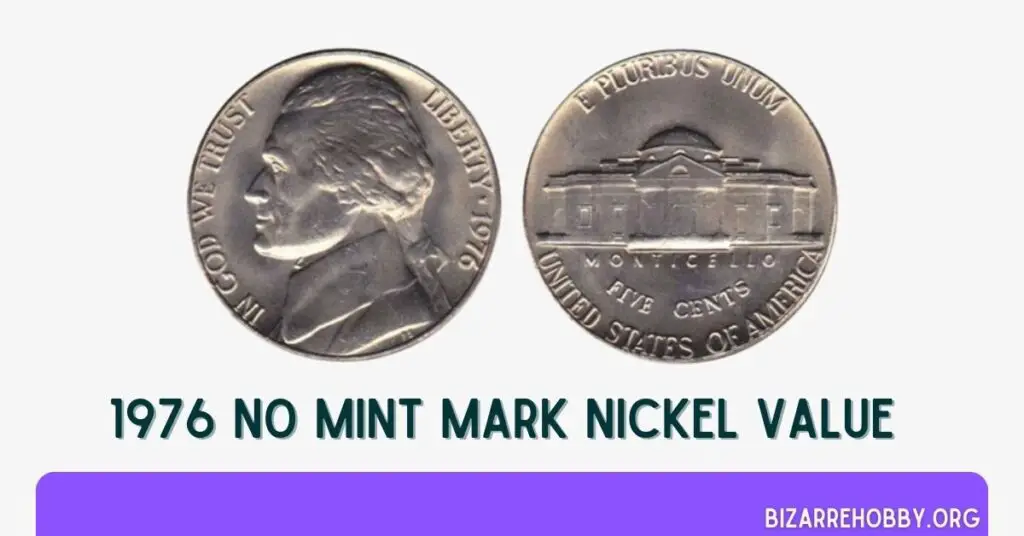
In 1976, the Philadelphia mint produced 367,124,000 nickels without a mint mark. These coins are relatively inexpensive in grades XF to AU, typically valued at around $0.05. For coins in mint state, the value increases slightly. Those in MS 60 to MS 63 grades can be purchased for $1 to $6, while higher grades range from $6 to $12. The most valuable pieces, graded MS 66, can cost around $55.
Auction prices can be significantly higher, especially for rare, well-preserved specimens. For example, a nickel graded MS 69 sold for $2,175 on eBay in 2022. The Full Steps (FS) varieties, which have at least five visible steps on Monticello, are particularly valuable.
An MS 64 FS nickel is worth about $45, while those in MS 65 to MS 66 grades range from $185 to $1,100. The most valuable MS 67 FS nickels are estimated to be worth between $2,000 and $3,500, with one selling for $4,025 at an auction in 2010.
1976 D Nickel Value
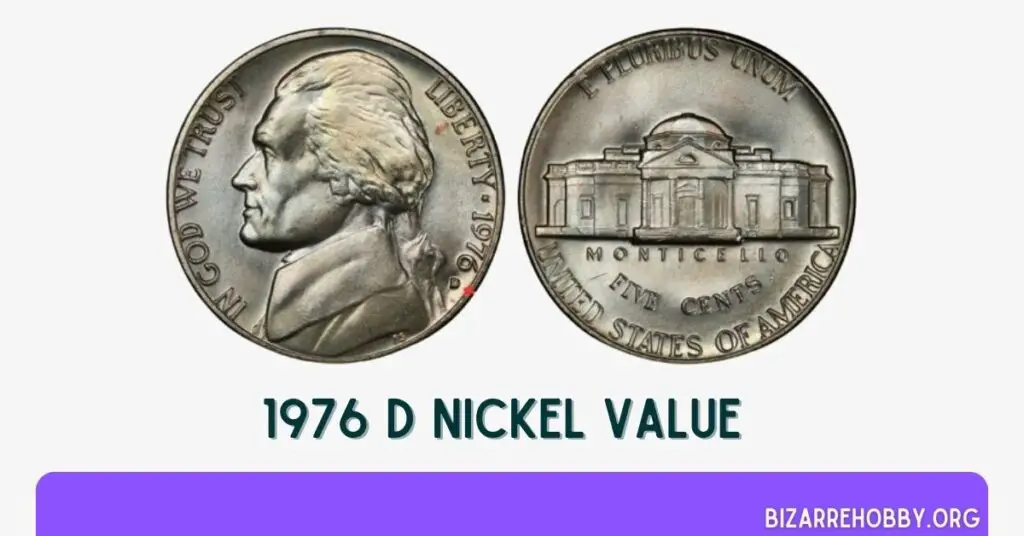
The Denver mint produced 563,964,147 nickels in 1976. In circulated grades, these coins are valued at $0.05. Coins in MS 60 to MS 63 grades are worth $1 to $6, while better-graded pieces range from $6 to $10. The most valuable MS 66 nickels from this mint are priced around $42. Auction prices can be much higher, with one specimen selling for $1,700 on eBay in 2018.
The Full Steps variety from Denver is more valuable than regular strikes. Coins in MS 64 and MS 65 grades are priced between $11 and $20, while MS 66 FS nickels are worth about $300. The highest-priced specimens, graded MS 67, are estimated at $3,500.
1976 Proofs Nickel Value
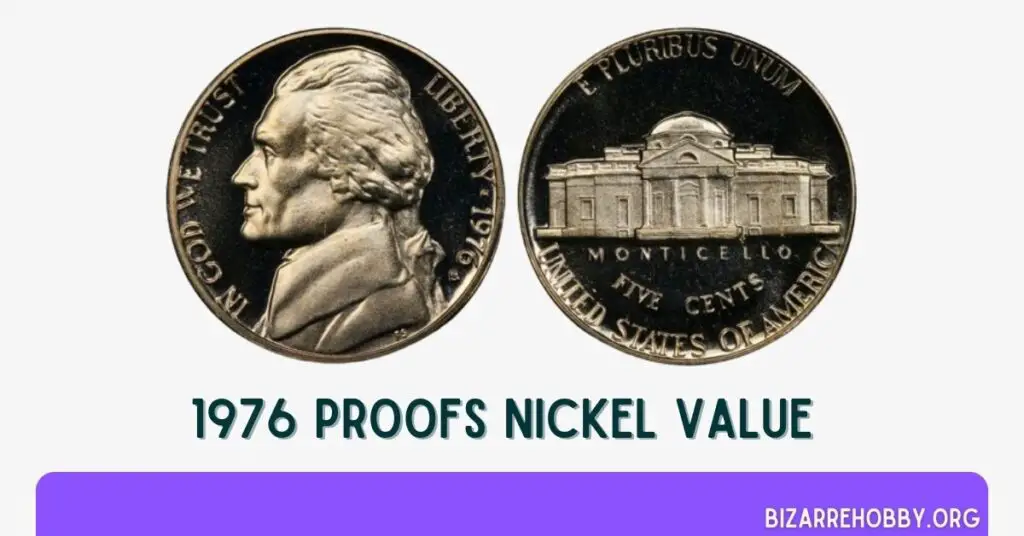
The San Francisco mint produced 4,149,730 proof nickels in 1976. Coins in PR 60 to PR 65 grades can be purchased for less than a dollar, while higher-graded proofs range from $2 to $10. The most expensive 1976 proof nickels with the “S” mint mark, graded PR 70, are valued at $440. However, one such coin set an auction record of $4,230 at Heritage Auctions in 2015.
Rare 1976 Nickel Error List
Error coins are a common occurrence in the minting process, and the 1976 nickels are no exception. These coins feature a range of imperfections, from barely noticeable to distinct, making them unique and collectible.
1976 Nickels Struck on the Wrong Planchet Error
One frequent error involves coins struck on planchets intended for other denominations, either domestic or foreign. While mints typically destroy such errors, some manage to enter circulation, often becoming highly valuable.
1976 Nickels Struck on a 10-cent (Dime) Planchet Error
This error occurs when a dime planchet is mistakenly used in a nickel press, resulting in a nickel design on a smaller planchet. These coins often have partial or missing inscriptions due to the size difference. They measure 0.70 inches (17.91 mm) in diameter and weigh 0.07 ounces (2.27 g), compared to the standard 0.84 inches (21.21 mm) and 0.18 ounces (5 g).
1976 Nickels Struck on a Philippine 1-Sentimo Planchet Error
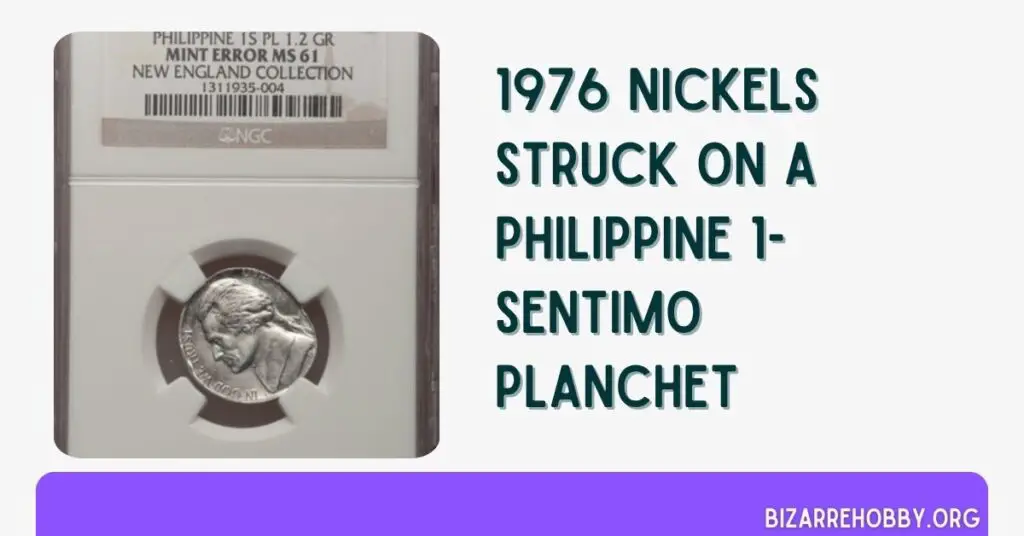
In this case, a 1976 nickel was struck on a planchet intended for a Philippine Sentimo coin. Composed of 95% aluminum with magnesium, these planchets weigh only 0.04 ounces (1.2 g). The resulting nickels have a slightly interrupted design due to the Sentimo’s dimensions.
1976 Nickel Curved Clip Error
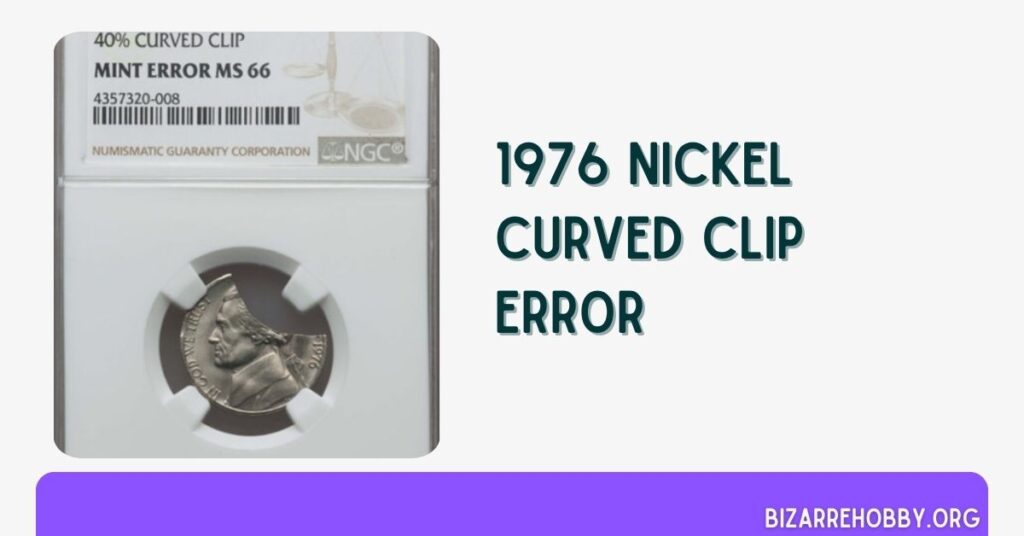
A curved clip error occurs during the cutting process. A 1976 nickel with this error can be valued up to $100.
1976 Nickel Off-center Error

An off-center error happens when the coin is struck off-center, resulting in a partial design and a blank area along the rim. The size of this blank area, expressed as a percentage, depends on how far off-center the strike was. Collectors particularly value coins with about 50% off-center strikes.
1976 Nickels Struck on a Split Planchet
A split planchet error can occur when gas, dirt, or grease remains on a metal blank during planchet strip preparation. This can cause the planchet to peel, flake, or split. Such errors can occur before or after the strike and can make 1976 nickels worth several tens of dollars.
Where to Sell Your 1976 Nickel?
Knowing the value of your 1976 Nickel is one thing, but knowing where to sell them is another. Here are some recommended sites for selling coins online, complete with introductions, pros, and cons.
What to look for in a 1976 nickel?
When evaluating a 1976 nickel, there are several key factors to consider that can significantly impact its value:
- Mint Mark: Check for the presence and type of mint mark. Nickels from Philadelphia have no mint mark, while those from Denver have a “D” and proof coins from San Francisco have an “S”. Each mint mark can affect the coin’s rarity and value.
- Condition and Grade: The coin’s condition is crucial. Look for coins with minimal wear and clear details. Higher grades, such as MS (Mint State) and PR (Proof), are more valuable. Coins with Full Steps (FS) on Monticello are particularly prized.
- Errors and Varieties: Error coins can be highly valuable. Look for nickels struck on the wrong planchet, off-center strikes, curved clips, or split planchets. These errors make the coin unique and can significantly increase its worth.
- Luster and Eye Appeal: A coin’s luster and overall eye appeal can also affect its value. Coins with a bright, original luster and no signs of cleaning or damage are more desirable.
- Historical Significance: Consider the historical context of the coin. The 1976 nickel is part of the long-running Jefferson series, which adds to its collectible appeal.
Which 1976 nickels are particularly valuable?
- A 1976 S DCAM nickel in PR 70 grade sold for $4,230 at Heritage Auctions in April 2015.
- A 1976 FS nickel in MS 67 grade sold for $4,025 at Heritage Auctions in February 2010.
- A 1976 S nickel in PR 70 grade sold for $2,975 on eBay in May 2022.
- A 1976 nickel in MS 69 grade sold for $2,175 on eBay in August 2022.
- A 1976 D FS nickel in MS 67 grade sold for $1,800 at Heritage Auctions in April 2021.
- A 1976 D nickel in MS 63 grade sold for $1,700 on eBay in July 2018.
- A 1976 S CAM nickel in PR 67 grade sold for $47 on eBay in September 2018.
- A 1976 S DCAM nickel in PR 68 grade sold for $15 on eBay in April 2018.
FAQs on 1976 Nickel Value
Are 1976 nickels valuable and Rare?
1976 nickels are not particularly rare, but Full Steps varieties and certain error coins can be scarce, especially in higher grades.
How much are the 1976 nickels (No Mint mark) worth?
1976 nickels in circulated condition are worth about $0.05. In mint state, their value ranges from $0.10 to $2,800, depending on the grade and the number of visible steps in front of Monticello.
What is the priciest nickel?
The most expensive nickel ever sold at auction is the 1913 Liberty Head nickel with CENTS (Type 2) in PR 66 grade, which fetched $4,560,000 in 2018. The costliest Jefferson nickel, produced in San Francisco in 1954, is a Full Steps variation in MS 67 grade that sold for $35,250 in 2020.
Final Thoughts
The 1976 nickel is a fascinating piece of American numismatic history. Whether you’re a novice collector or an experienced numismatist, these coins offer a blend of affordability and historical significance. By paying attention to mint marks, condition, errors, and overall appeal, you can find valuable additions to your collection. Remember, the joy of collecting lies not just in the value but in the stories and history each coin represents.
